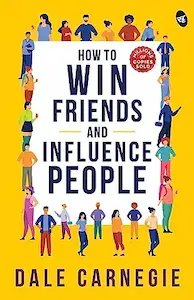How to Win Friends and Influence People - Summary
Dale Carnegie

Introduction
“How to Win Friends and Influence People” by Dale Carnegie is a self-help book that was first published in 1936. The book has sold over 30 million copies worldwide and has been translated into numerous languages. It is considered to be one of the most influential books in the genre of self-improvement and personal development. The book provides practical advice on how to improve one’s social skills and build lasting relationships.
Part 1: Fundamental Techniques in Handling People
The first part of the book focuses on the fundamental techniques in handling people. Carnegie emphasizes the importance of understanding human nature and how to interact with people in a positive way. He suggests that one should always try to see things from the other person’s perspective and avoid criticizing or condemning them. Instead, he recommends using praise and appreciation to motivate people.
Carnegie provides several examples and anecdotes to illustrate his points. For instance, he tells the story of how Charles Schwab, the president of Bethlehem Steel, used praise to improve the productivity of his workers. Schwab wrote a letter to one of his employees, complimenting him on his work and offering him a bonus. The employee was so motivated by the praise that he went on to improve his performance and become one of the company’s top performers.
Part 2: Six Ways to Make People Like You
The second part of the book focuses on six ways to make people like you. Carnegie emphasizes the importance of being genuinely interested in other people and showing them that you care. He suggests that one should always listen actively, ask questions, and remember people’s names.
Carnegie provides several examples and anecdotes to illustrate his points. For instance, he tells the story of how Franklin D. Roosevelt, the former US president, used his charm and social skills to win over his opponents. Roosevelt was known for his ability to remember people’s names and make them feel important. He used this skill to build lasting relationships with his colleagues and opponents alike.
Part 3: How to Win People to Your Way of Thinking
The third part of the book focuses on how to win people to your way of thinking. Carnegie emphasizes the importance of understanding people’s motivations and using logic and reason to persuade them. He suggests that one should always try to find common ground and avoid arguments and confrontations.
Carnegie provides several examples and anecdotes to illustrate his points. For instance, he tells the story of how Abraham Lincoln, the former US president, used his persuasive skills to win over his opponents. Lincoln was known for his ability to use logic and reason to persuade people to his point of view. He used this skill to pass several important pieces of legislation during his presidency.
Part 4: Be a Leader: How to Change People Without Giving Offense or Arousing Resentment
The fourth part of the book focuses on how to be a leader and change people without giving offense or arousing resentment. Carnegie emphasizes the importance of leading by example and inspiring others to follow. He suggests that one should always try to be positive and avoid criticizing or blaming others.
Carnegie provides several examples and anecdotes to illustrate his points. For instance, he tells the story of how Henry Ford, the founder of Ford Motor Company, used his leadership skills to inspire his workers. Ford was known for his ability to motivate his workers and create a positive work environment. He used this skill to build one of the most successful companies in the world.
Conclusion
In conclusion, “How to Win Friends and Influence People” by Dale Carnegie is a timeless classic that provides practical advice on how to improve one’s social skills and build lasting relationships. The book is filled with examples and anecdotes that illustrate Carnegie’s points and make the book engaging and informative. The book is a must-read for anyone who wants to improve their interpersonal skills and become a more effective communicator.